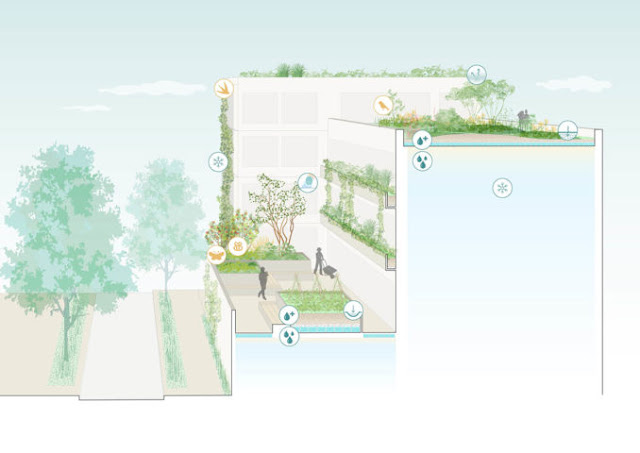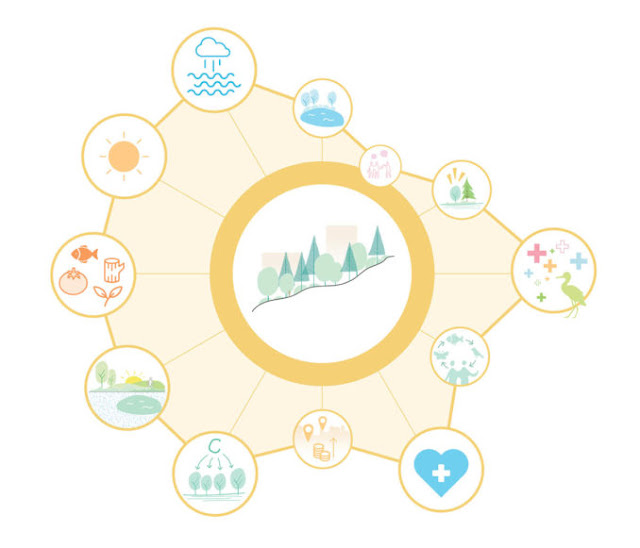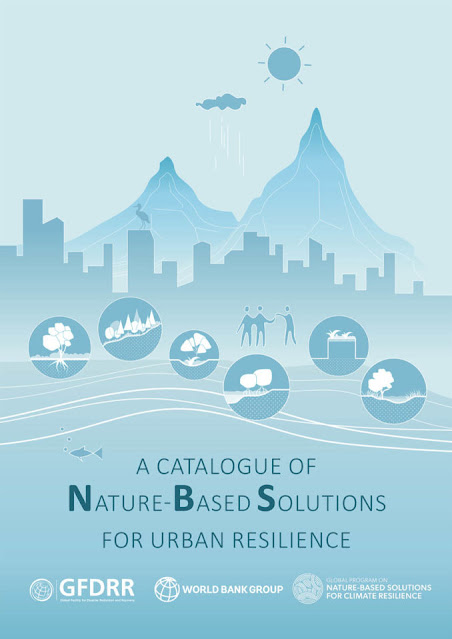- Κάθε ΛBO είναι συγκεκριμένη για συγκεκριμένη τοποθεσία και χρήση . Η επιλογή του κατάλληλου ΛΒΟ βασίζεται στις φυσικές ιδιότητες του νερού, των εδαφών, των δέντρων, της βλάστησης και της τοπογραφίας κάθε τοποθεσίας.
- Κάθε ΛΒΟ είναι μέρος ενός μεγαλύτερου φυσικού συστήματος. Ένα επιτυχημένο ΛΒΟ συμβάλλει στην ενσωμάτωση της τοποθεσίας του στο ευρύτερο οικοσύστημα της πόλης και της περιοχής. Ακόμη και ένα αυτόνομο ΛΒΟείναι ενσωματωμένο στο φυσικό πλαίσιο της πόλης.
- Κάθε λειτουργική ΛΒΟ είναι αποτέλεσμα μιας διεπιστημονικής, πολυμερούς διαδικασίας και προσφέρει πολλαπλά οφέλη. Η δημιουργία ενός υψηλής ποιότητας, πολυδιάστατου τοπίου απαιτεί τη συμβολή των γεωτεχνκών, των μηχανικών, άλλων επιστημόνων και των ίδιων των κοινοτήτων.
- Διαδικασίες- σχετικές με την ανθεκτικότητα, τις λειτουργίες και τα οφέλη των ΛΒΟ, συμπεριλαμβανομένης του καθαρισμου ατμόσφαιρας, της ψύξης και της δέσμευσης άνθρακα.
- Λειτουργίες – ογκομετρική/ποσοτική ικανότητα ρύθμισης των επιπτώσεων πιθανών φυσικών κινδύνων.
- Οφέλη – ικανότητα των ΛΒΟ να παρέχει κοινωνικά, οικονομικά και περιβαλλοντικά οφέλη, όπως μείωση του κινδύνου πλημμύρας, θερμικού στρες, βελτίωση της ανθρώπινης υγείας, δημιουργία θέσεων εργασίας και βελτίωση της βιοποικιλότητας.
- Καταλληλότητα – περιβαλλοντικές, τεχνικές και αστικές απαιτήσεις για την υλοποίηση καθώς και πληροφορίες για τη συντήρηση και το κόστος.
- Πρακτική ΛΒΟ – βασικά παραδείγματα (σε παγκόσμιο επίπεδο) με σχετικά διδάγματα σχετικά με κοινωνικές, οικονομικές πτυχές και εκτιμήσεις διακυβέρνησης.
Felixx develops a catalogue of Nature-Based Solutions for Urban Resilience
Felixx Landscape Architects developed ‘’A Catalogue of Nature-Based Solutions for Urban Resilience” with the World Bank Group and Global Facility for Disaster Reduction and Recovery (GFDRR), in participation with Nelen & Schuurmans, UNStudio, Rebel and UNSense. The catalogue was officially launched during the UN Climate Change Conference (COP26) in Glasgow. An integral version of the catalogue can be downloaded from the World Bank’s Open Knowledge Repository
Despite the growing worldwide demand for Nature-Based Solutions (NBS) in cities, planners and politicians still have limited knowledge of when and how to build with nature. The NBS catalogue provides guidance, real-world examples and technical assistance to help identify feasible nature-based investments that address the challenges of urban resilience.
The Power of Nature-Based Solutions
In the past, societies put hope in heavy infrastructural works to protect urban environments from natural hazards. To a large extent, this infrastructure disconnected cities from their natural limitations and qualities. Currently we are confronted with a multitude of natural challenges at the same time, and at the same place. Individual infrastructural solutions no longer provide adequate protection from multiple hazards.
‘‘Instead of scaling up our fights against natural forces, we need to fundamentally shift towards a mode of collaboration with the power of nature. Human and ecological processes need to be reconnected, instead of more divided. – Michiel Van Driessche, Felixx.
Landscape Approach
The NBS catalogue signals the watershed in urban planning from the predominantly engineering-based approach to the focus on highly functional natural landscapes. The use of NBS positions landscape architects at the forefront of climate adaptation. The new NBS approach is organized around the following principles:
- Each NBS is site specific. The selection of an appropriate NBS is based on the of natural properties of water, soils, trees, vegetation and topography of each location.
- Each NBS is a part of a larger natural system. A successful NBS helps integrate its location into the larger ecosystem of the city and the region. Even a stand-alone NBS is embedded the city-wide natural framework.
- Each functional NBS is a result of an interdisciplinary, multistakeholder process and delivers multiple benefits. Creation of a high quality, multidimensional landscape requires input from the engineers, scientists and communities.
Technical profile NBS processes. © Felixx
“Know where your city is and recover its logical position in relation to the greater regional ecosystem. Reestablishing this relationship can make our cities healthier and safer.” – Eduardo Salinas, Felixx.
NBS Families
To a degree, the position of a city determines the suitability of NBS types. To help select appropriate NBS the catalogue contains fourteen NBS categories ranging from Urban Forests, Building Solutions, and Wetlands to Bioretention Areas, River Floodplains, Mangrove Forests and Sandy Shores. We call these the NBS families. Each family is described, visualized and assessed for its capacity based on the following criteria:
- Processes- relevant for the resilience, functions and benefits of NBS, including infiltration, cooling and carbon sequestration.
- Functions – volumetric/quantitative capacity to regulate the effects of potential natural hazards.
- Benefits – capacity of NBS to deliver social, economic, and environmental benefits, such as reduction of flood, heat stress risk, human health improvement, job creation and biodiversity enhancement.
- Suitability – environmental, technical and urban requirements for implementation as well as information on maintenance and costs.
- NBS practice – key examples (worldwide) with relevant lessons learned on social, financial aspects and considerations of governance.
The World Bank and NBS
Tackling climate change and biodiversity loss will require major social, economic and technological changes, many of which are costly and will require large investments. In urban areas, NBS can strengthen resilience to climate shocks while bringing additional benefits for vulnerable communities and the environment.
“Integrating NBS in complex urban settings can be transformational for communities. However, it is not easy and requires the right knowledge and tools at the right time. The NBS catalogue with its strong landscape architecture designs is such a tool that can bring inspiration, examples and implementation guidance for cities globally” – Brenden Jongman, Global Facility for Disaster Reduction and Recovery (GFDRR), World Bank
With the launch of NBS catalogue at COP26 the World Bank Group highlights the importance of NBS as a viable and cost effective alternative for conventional gray infrastructure. The structure of the NBS catalogue and focus on application and practice of NBS families underlines the importance of moving NBS from the theoretical discussions towards actual (and global) implementation.
Felixx and NBS
Felixx has been developing a strong portfolio of NBS in various projects. Successful examples are the waterfront in Shenzhen, Rijnvliet, Edible Neighborhood, and Imagewharf. Projects Campus Eemsdelta, Jonas & Floating Gardens are currently under construction. The NBS catalogue offers us the theoretical basis to further elaborate, expand and intensify the use of NBS in our work.
Image Credits: As captioned
From: https://worldlandscapearchitect.com/felixx-develops-catalogue-of-nature-based-solutions-for-urban-resilience/
Αναλογα άρθρα:
- Τι είναι το SuDS και πώς λειτουργούν; Sustainable Drainage Systems
- Παρτέρια -Ζαρτινιέρες Απορροής και συλλογής νερού Βioswales
- Τι είναι η Πράσινη υποδομή για διαχείριση νερού;
- ΣΥΛΛΟΓΉ ΒΡΌΧΙΝΟΥ ΝΕΡΟΎ
- ΤΑ ΠΑΡΚΑ ΔΙΑΧΕΙΡΙΣΗΣ ΟΜΒΡΙΩΝ ΣΤΟ ΜΕΛΛΟΝ ΜΑΣ;
- DRAINAGE at landscape- ΑΠΟΣΤΡΑΓΓΙΣΗ ΣΤΟΝ ΚΗΠΟ
- ΕΡΓΑ ΜΕ ΕΠΑΝΑΧΡΗΣΙΜΟΠΟΙΗΣΗ ΥΔΑΤΩΝ ΣΤΗ ΚΗΠΟΤΕΧΝΙΑ
- ΓΙΑΤΙ ΠΛΗΜΜΥΡΙΖΕΙ Η ΑΘΗΝΑ ;
- Συλλογή και χρήσεις νερού
- Προληψη για τις πλημμύρες που θα ερθουν....
- Ανοιχτή επιστολή ενός γυρίνου προς την Περιφερειάρχη Αττικής κα Δούρου
- Τι είναι η Πράσινη υποδομή για διαχείριση νερού;
- Η Μαδρίτη πρασινίζει για να γλιτώσει από τους καύσωνες
- Δημιουργήσετε μια λίμνη με υδρόβια φυτά σε εσωτερικό χώρo
- Πανέμορφοι κήποι με νερό
- ΠΩΣ Ο ΜΕΓΑΛΥΤΕΡΟΣ ΤΕΧΝΗΤΟΣ ΥΔΡΟΒΙΟΤΟΠΟΣ ΣΤΟΝ ΚΟΣΜΟ «ΦΙΛΤΡΑΡΕΙ» ΑΠΟΒΛΗΤΑ ΠΕΤΡΕΛΑΙΟΠΗΓΩΝ
Αρθρα από τον Οδηγό Διαχείρισης Ομβρίων στην Πόλη
























Δεν υπάρχουν σχόλια:
Δημοσίευση σχολίου